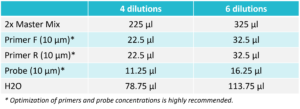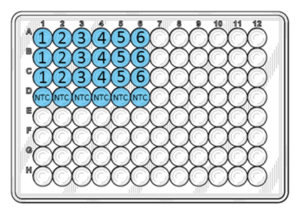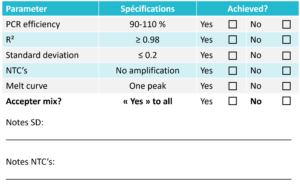# Real-Time PCR Mix Evaluation Guide
When evaluating a new real-time PCR master mix, it's crucial to consider the right parameters. This guide offers a protocol along with tips on quickly assessing a real-time PCR master mix.
---
**Real-Time PCR Mix Evaluation Guide**
---
## Step-by-Step Evaluation Protocol
### 1. Prepare a DNA Dilution Series
Create a DNA dilution series following the pattern shown below. Gently mix the tubes by flicking them (do **not vortex!**) and centrifuge briefly.

*Note:* For genomic DNA, include tubes 1-4. For other types of DNA, include tubes 1-6. The initial DNA concentration is 100 ng/µl, with final concentrations noted in the boxes above each tube.
---
### 2. Prepare the Reaction Mix
Mix the components as per the table below. After combining all elements, briefly vortex the mixture and spin it down.

For Probe-Based Assays:

---
### 3. Distribute the Reaction Mix
Add 20 µl of the prepared reaction mix into the bottom of the blue wells, following the layout in the image below.

---
### 4. Add the DNA Samples
Transfer 5 µl of DNA from the dilution series into the respective wells. Ensure the pipette tip remains submerged as little as possible to avoid contaminating the sides of the wells. The DNA should enter the liquid directly.

*Tip:* Avoid repeatedly pipetting into the wells—mixing occurs naturally during the initial heating phase of the PCR run. Add PCR-grade water to the NTC (non-template control) wells instead of DNA.
---
### 5. Run the Plate
Use the PCR cycling protocol outlined below when running the plate on your real-time PCR instrument. Conduct the melt curve analysis according to the instrument's default settings.

For Probe-Based Assays:
No melt curve settings are required.
---
### 6. Analyze the Results
To approve the master mix, ensure the results align with the criteria listed below. Use the table provided to assess the master mix.

#### Standard Curve Analysis
When examining the standard curve, focus on three key parameters: PCR efficiency, R² value, and replicate consistency.
- **PCR Efficiency:** Indicates how effectively the target is amplified and should fall between 90-110%. This is a critical parameter.
- **R² Value:** Measures how closely the data fits the regression line, ideally ≥ 0.98.
- **Replicate Consistency:** Reflects pipetting accuracy; the standard deviation should be ≤ 0.2.
#### Melt Curve Assessment
In the melt curve, expect a single distinct peak at the intended melt temperature of the product. Note that the melt temperature depends on pH and buffer conditions, so slight variations between mixes are normal.
- Ensure no peaks coincide with the NTCs, as this could indicate contamination.
- Small secondary peaks are acceptable unless they interfere with the primary product signal.
#### Cq Values
Cq values should be evaluated alongside PCR efficiency. While higher Cq values may result from low efficiency, they shouldn’t be the sole focus of analysis. Factors like SYBR level, ROX level, and target length can also influence Cq values.
#### SYBR Level
SYBR levels are less relevant for assessing performance. Adjustments can easily be made by modifying the buffer composition without impacting overall quality.
#### Comparing Two Mixes
When comparing two mixes, use identical primers and concentrations while preparing separate reaction mixes for each. Distribute samples accordingly and analyze melt curves separately.
---
## Additional Considerations
This guide emphasizes simplicity and efficiency. For a comprehensive evaluation, consider other vital factors such as primer/probe design, annealing temperature, inhibitor presence, and appropriate controls.
---
## Extract from Ampliqon Items
- **RealQ Plus 2x Master Mix Green Low ROXâ„¢ (A324499)**
- **RealQ Plus 2x Master Mix for Probe Low ROXâ„¢ (A314499)**
## Learn More
- Flyers:
- "Study of Fast Cycling Real-Time PCR Conditions using RealQ Plus Master Mixes"
- "REALQ PLUS MASTER MIXES"
- Online Search: Explore real-time master mixes.
- Contact Us:
- Phone: +33 4 70 03 73 06
- Email: [Insert email here]
---
While this guide provides a solid foundation, always tailor evaluations based on specific experimental needs and equipment capabilities. Proper assessment ensures reliable and reproducible results across different applications.
1. Premium Natural Ferment Jujube Fruit Extract Powder Animal Feed Grade Product Description:
Given the increasing demands for the quality and safety of animal-derived foods and the strict regulations on the use of antibiotics in animal feed, the use of functional feed additives has attracted increasing research and development. Jujube fruit is an energy-rich food with antioxidant, antibacterial, and antidiarrheal properties. With the expanding areas of cultivation to jujube trees and the intensive processing of jujube in Asia, especially in China, a large number of jujube by-products are produced. These by-products are used widely in animal feed for pigs, chicken, cattle, goats, and fish, as they improve growth performance, promote digestive tract health, and enhance the quality of animal products.
Keywords: jujube by-product; feed additive; nutrient; biological function
2. Product functions:
1) The sugar and protein of feed-grade jujube powder are easy to be absorbed and utilized by animals, and the effect is better
than other energy raw materials.
2) Feed jujube powder can improve the feed conversion rate and significantly reduce the cost of feed use.
3) After use, cows can appetize and increase food consumption to increase milk production.
4) After being used by chickens and ducks, it can effectively reduce laying fatigue and extend the laying period.
5) Feed jujube powder is suitable for meat livestock and poultry such as broilers, ducks, and cattle.
Dried Jujube Fruit Powder /Jujube Powder feed grade//Jujube Powder for Animal Feed
Jujube Powder Feed,100% Natural Pure Jujube Powder,Jujube Powder Feed Grade,Jujube Powder For Animal Feed
Zhengzhou Bridge Biochem Co.,Ltd. , https://www.biochemfeeds.com